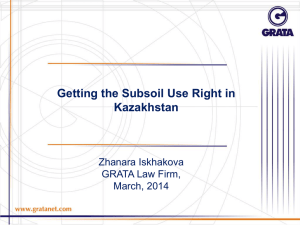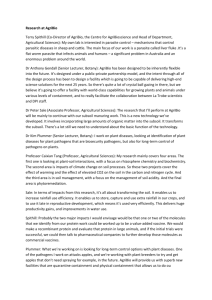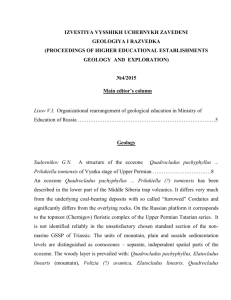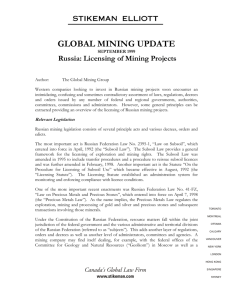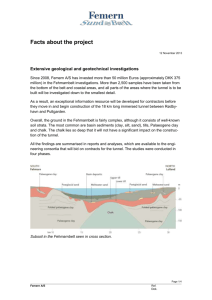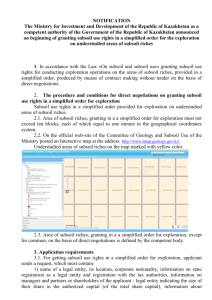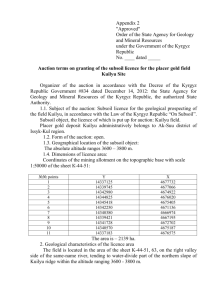Unofficial translation
advertisement
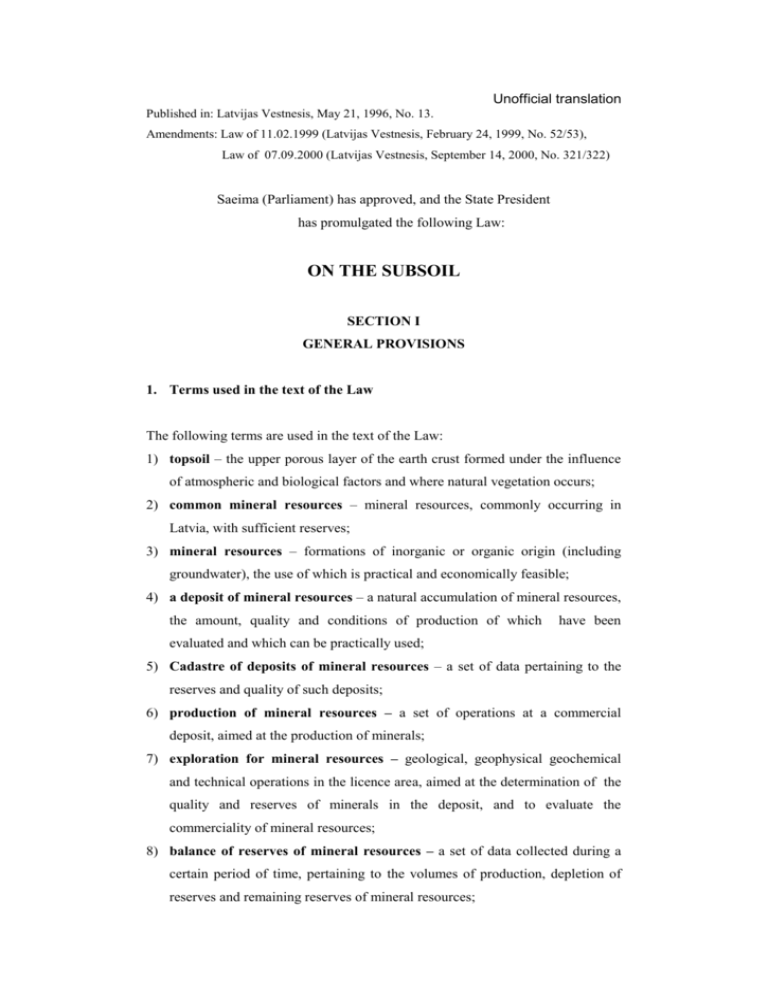
Unofficial translation Published in: Latvijas Vestnesis, May 21, 1996, No. 13. Amendments: Law of 11.02.1999 (Latvijas Vestnesis, February 24, 1999, No. 52/53), Law of 07.09.2000 (Latvijas Vestnesis, September 14, 2000, No. 321/322) Saeima (Parliament) has approved, and the State President has promulgated the following Law: ON THE SUBSOIL SECTION I GENERAL PROVISIONS 1. Terms used in the text of the Law The following terms are used in the text of the Law: 1) topsoil – the upper porous layer of the earth crust formed under the influence of atmospheric and biological factors and where natural vegetation occurs; 2) common mineral resources – mineral resources, commonly occurring in Latvia, with sufficient reserves; 3) mineral resources – formations of inorganic or organic origin (including groundwater), the use of which is practical and economically feasible; 4) a deposit of mineral resources – a natural accumulation of mineral resources, the amount, quality and conditions of production of which have been evaluated and which can be practically used; 5) Cadastre of deposits of mineral resources – a set of data pertaining to the reserves and quality of such deposits; 6) production of mineral resources – a set of operations at a commercial deposit, aimed at the production of minerals; 7) exploration for mineral resources – geological, geophysical geochemical and technical operations in the licence area, aimed at the determination of the quality and reserves of minerals in the deposit, and to evaluate the commerciality of mineral resources; 8) balance of reserves of mineral resources – a set of data collected during a certain period of time, pertaining to the volumes of production, depletion of reserves and remaining reserves of mineral resources; 9) prospecting for mineral resources – purposeful geological studies aimed at finding deposits of minerals prospective for the subsequent exploration; 10) cased well – a cased well aimed at the intake of groundwater; 11) geological information – data pertaining to the structure, properties and resources of the subsoil; 12) geological investigations – all types of geological operations aimed at determining the structure, composition, properties, condition of the subsoil, as well as the regularities of occurrence and distribution of mineral resources and useful properties of the subsoil; 13) driven or drilled well – a strengthened well with pipes aimed at the intake of groundwater; 14) licence area – a subsoil area (block) or a combination of several areas (blocks) or their parts aimed at a concrete type of the use of the subsoil, within the limits of which a permit (licence) for a certain use of the subsoil or a permit for the production of common minerals is valid; 15) hydrocarbons – untreated oil (crude oil), natural gas and condensate; 16) easement – the right to use the subsoil when property rights regarding the use of the subsoil are limited in favour of a certain entity; 17) mineral resources of State importance – hydrocarbons [untreated oil (crude oil), natural gas] and groundwater (freshwater, mineral water, water for the use by the industry); 18) deposit of mineral resources of State importance – a deposit determined as such by the Cabinet of Ministers, located within the Latvian territory or the Exclusive Economic Zone (EEZ), and the reserves of which satisfy the needs of the State or its several regions in a mineral resource; 19) subsoil area of State importance – subsoil areas determined as such by the Cabinet of Ministers, located within the Latvian territory or EEZ, possessing certain subsoil properties, and the use of which may be of a particular importance in the State economy, defence and other fields; 20) subsoil – a part of the earth crust below topsoil and surface water as deep as it is economically and technologically possible to carry out geological investigations, production of mineral resources or to use the subsoil; 21) use of the subsoil – geological investigations, production of mineral resources and the use of the properties of the subsoil; 22) permit (licence) for the use of the subsoil – a document confirming the right of its holder to use the subsoil within stated limits, for stated purposes, in the -2- stated manner and during a certain period of time, complying with the stated requirements and regulations; 23) the Earth crust – the external hard layer of the Earth, its thickness in Latvia being 40-64 km; 24) the subsoil fund – all the usable or non-usable subsoil, notwithstanding the type of property (owner) within the Latvian territory or EEZ; 25) subsoil monitoring – a system of the subsoil observations, control, analyses and forecasting; 26) State geological supervision of the subsoil fund – a system of measures in compliance with the administrative acts, aimed at the supervision of the procedures of the use of the subsoil, the target of which is to supervise the compliance with the procedures of the use of the subsoil as determined by the legal acts, administrative documents and permits or licences (the compliance of geological investigations with the programme and evaluation of achieved results, accept and accounting of reserves of mineral resources). (As amended by the law “Amendments to the law “On the Subsoil” of February 11, 1999, coming into force on March 10, 1999). 2. The implementation of the Law This Law determines the procedures for comprehensive, rational and environmentally safe use of the subsoil as well as the requirements for the use and protection of the subsoil. 3. Property rights (1) The subsoil and all mineral resources therein belong to the landowner. (2) The landowner may use the subsoil, insofar as this Law and other legal acts do not limit his rights. SECTION II SUPERVISION OF THE SUBSOIL FUND OF THE REPUBLIC OF LATVIA 4. Institutions supervising the use of the subsoil fund -3- (1) The supervision of the use of the subsoil fund is carried out, on behalf of the State, notwithstanding the type of property (owner), in compliance with procedures contained in the administrative acts, by: 1) the Ministry of Environmental Protection and Regional Development (MEPRD) and institutions within its structure, under its administration and supervision; 2) the Ministry of Economy (ME); 3) the local authorities of parishes and towns (cities). (2) The competence of the above institutions is defined by this and other laws, as well as the Statutes of the above Ministries and the State Geological Survey (SGS), and other administrative acts. (3) SGS is a State administrative institution under the administration of MEPRD which, within the limits of its competence, safeguards the rational use of the subsoil and carries out the geological supervision of the state subsoil fund. The activities of SGS are governed by this Law and the Statutes approved by the Cabinet of Ministers. (4) ME organises competitions for hydrocarbon prospecting, exploration and production (permits) licences for the areas and in compliance with the procedures determined by the Cabinet of Ministers and issues such permits (licences), and carries out administrative supervision of hydrocarbon prospecting, exploration and production. (5) The local authorities of parishes and towns (cities), within the territories under their administration: 1) in accordance with the procedures approved by the Cabinet of Ministers and the limits determined by MEPRD issue permits (licences) for the use of common mineral resources within the yearly quotas and limitations, excluding the cases mentioned in 4(7) and 10(2); 2) control the remediation of sites of deposits of mineral resources. (6) The expenses of the local authorities necessary to carry out the functions delegated to them are covered from the fees received for the permits (licences) for the use of the subsoil. (7) If a deposit of mineral resources occurs within the territories administered by several parishes and towns (cities), or the local authorities use the right of easement, the permits (licences) for the use of subsoil are issued by SGS. -4- (As amended by the law “Amendments to the law “On the Subsoil” of February 11, 1999, coming into force on March 10, 1999). 5. The forms of supervision of the use of the subsoil (1) MEPRD, on behalf of the State and in compliance with the procedures set forward in this Law and other legal acts, while supervising the subsoil: 1) carries out the accounting of the reserves of mineral resources; 2) compiles the cadastre of the deposits of minerals and the balance of the reserves of minerals; 3) determines the volumes of production of minerals (except hydrocarbons); 4) prepares standards (norms, regulations) for the geological exploration of the subsoil, the use and the protection thereof, the safety regulations in the operations in conjunction with the use of the subsoil. (2) The Cabinet of Ministers, in the interests of the State, has the right to limit the rights of legal and physical entities regarding the land and the subsoil belonging to them, in cases stated by the legal acts, by imposing the limitations of the right to use the property. (3) In the interests of the national security, protection of the environment and the subsoil, the use of mineral resources and deposits of State importance, the use of subsoil areas of State importance, the construction and use of the structures of State importance, the land may be alienated from the landowners in compliance with the Law ''On the Compulsory Alienation of Real Estate for State and Society Needs''. (As amended by the law “Amendments to the law “On the Subsoil” of February 11, 1999, coming into force on March 10, 1999). SECTION III THE USE OF THE SUBSOIL 6. Basic principles of the use of the subsoil (1) The subsoil is a non-renewable asset to be used, simultaneously, in the interests of landowners, the State and society. -5- (2) The cost of the subsoil is not included in the property cadastre cost; no property tax is payable for the subsoil. The use of the subsoil under the land belonging to or permanently used by entities for personal needs is free of charge. The commercial use of the subsoil is allowed if a pertinent permit (licence) is obtained in compliance with the provisions of Item 10 of this Law. (3) During the use of the subsoil, it is obligatory to comply with the regulations dealing with the protection and use of specially protected areas and objects, the regulations for the protection of cultural monuments and other regulating limiting the use of the subsoil. (4) In order to secure rational use and protection of the subsoil, the State and local authorities have the right to limit, interrupt or discontinue any physical or judicial entities' activities in conjunction with the use of the subsoil, in cases and based on conditions contained in this Law and other legal acts. 7. Purposes of the use of the subsoil The purposes of the use of the subsoil are as follows: 1) to carry out geological exploration, scientific research, professional training and subsoil monitoring; 2) the production (mining) of mineral resources; 3) the construction and use of underground structures not related to the production of mineral resources; 4) the establishment of specially protected natural areas and objects; 5) the promotion of recreation, tourism and health-related measures; 6) the collection of samples for mineralogical, palaeontological and other geological collections; 8. Users of the subsoil The subsoil is used by: 1) the landowner; 2) the entity to whom land has been granted for permanent use; 3) legal or physical entity, including foreign legal and physical entities, who have signed an agreement with the landowner. 9. Types and duration of the use of the subsoil -6- (1) The types of the use of the subsoil are as follows: 1) for an unlimited time period; 2) for a limited time period. (2) For an unlimited time period, the subsoil may be allocated for the construction of subsoil objects not related to the production of mineral resources and for other State and society needs (specially protected geological objects, scientific and training sites, the establishment of natural monuments and other subsoil and above-ground formations). (3) For a limited time period, the subsoil may be allocated: 1) for geological exploration purposes - for up to 5 years; 2) for the production of minerals - for up to 25 years; 3) for geological exploration and subsequent production of minerals - for up to 30 years. (4) The terms and the types of the use of the subsoil shall be stated in the permit (licence) for the use of the subsoil. (As amended by the law “Amendments to the law “On the Subsoil” of February 11, 1999, coming into force on March 10, 1999). 10. The procedures of the use of the subsoil (1) The use of the subsoil may be initiated only after a permit (licence) has been obtained in compliance with the procedures set forward by the Cabinet of Ministers (except cases mentioned in Item 11). The permits (licences) for the use of the subsoil are issued by: 1) by the local authorities of a parish or town (city) – in cases mentioned in 4(5); 2) ME – in cases mentioned in 4(4); 3) SGS – in all other cases. (2) The procedures of the use of minerals, mineral deposits and subsoil areas of State importance, those of hydrocarbon prospecting, exploration and production, as well as those regarding environmental protection during offshore hydrocarbon exploration and production operations are determined by the Cabinet of Ministers. Regulations of the Cabinet of Ministers also govern the use of mineral resources of State importance in -7- cases when the landowner and the owner of the equipment for production of minerals of State importance are not one and the same person. (3) Groundwater may be used only if a permit for water use has been obtained (except cases mentioned in Item 11). Permits for water use are issued by Regional Environmental Boards. (4) Permits (licences) for the use of the subsoil are issued for a fee. The size of the fees and the procedures of their payment are determined by the Cabinet of Ministers. (5) Permits (licences) for the use of the subsoil are issued to the local authorities of parishes and towns (cities) free of charge for the lands belonging to them, or the lands belonging to the State or the local authorities allocated to them for permanent use, based on applications of such local authorities and the stated volume of production, if as a result of the use of the subsoil, the produced minerals are to be used for the road maintenance, the development of the area and for the maintenance of buildings belonging to the local authorities. (6) It is prohibited to sell, give away, use as collateral, exchange or otherwise alienate permits (licences) for the use of the subsoil. If the user of the subsoil changes, the existing permit (licence) is cancelled, and the new user shall obtain a new permit (licence) in accordance with the procedures contained in this Law. In case the user of the subsoil, the holder of a permit (licence) or property rights for the enterprise are changed, the earlier issued permit (licence) is cancelled, and, in such a case, the new owner of the enterprise, accepting the obligations contained in the existing permit (licence), may receive a new permit (licence) without competition (sale). The change of ownership of a permit (licence) for hydrocarbon exploration and production may occur if endorsed by the Cabinet of Ministers. (7) The permits (licences) for the use of the subsoil under the lands belonging to the State or the local authorities are issued based on competition or sale. Any legal or physical or legal, including foreign legal and physical entities, can participate in competitions or sales. (8) Permits (licences) for the use of the subsoil are issued to landowners (excluding the State and the local authorities) for the lands belonging to them based on applications and within certain production limits. This procedure is not applicable to the cases when mineral resources and -8- deposits of State importance or subsoil areas of State importance are used. The landowner (except the State and the local authorities) may transfer the rights to use the subsoil to other legal and physical entities, by concluding an agreement, which is a necessary precondition for the issuance of permit (licence) for the use of the subsoil. (9) The landowner (excluding the State and the local authorities) has the right to arrange a competition or sale for the right to use the subsoil under the land he owns. Such a competition or sale and its conditions must be endorsed by SGS and the pertinent local authorities. (10) The general procedures for competitions or sales concerning the issuance of permits (licences) for the use of the subsoil and the procedures of competitions for hydrocarbon prospecting, exploration and production licensing are determined by the Cabinet of Ministers. (As amended by the law “Amendments to the law “On the Subsoil” of February 11, 1999, coming into force on March 10, 1999 and the law “Amendments to the law “On the Subsoil” of September 07,2000, coming into force on September 28, 2000). 11. The use of the subsoil without permits (licences) for the use of the subsoil The landowners (physical entities) and the physical entities to whom lands have been allocated for permanent use may use the subsoil within the limits of lands belonging to them without the permit (licence) for the use of the subsoil, complying with the provisions of Item 6(3) of this Law, and free of charge in the following cases: 1) the production of common mineral resources mentioned in the Appendix to this Law, excluding the cases when such activities are commercial; 2) To drill and use cased, driven and drilled water wells to the maximum depth of 20 metres and different structures (cellars, reservoirs, etc.) to the depth down to 5 metres for personal needs as well as water drains for land reclamation purposes to transport surface water. 12. Easement rights in the use of the subsoil -9- 1) The State Road Service and the State Forestry Service have the easement rights to use mineral resources under occupied lands if such mineral resources are necessary for the construction, repair and maintenance of roads. 2) The local authorities of townships and towns have the easement rights to use mineral resources under occupied lands if such mineral resources are necessary for the construction, repair and maintenance of roads, area development or for the maintenance of structures belonging to the local authorities. 3) The imposition of easement under Items 12(1) and 12(2) is decided, in each and every case, by the Cabinet of Ministers. 4) The compensation to the landowner for the aforementioned easement is determined based on mutual agreement. If such an agreement cannot be reached, the size of the compensation is determined by the court. 5) After the expiry of easement, the user of easement shall be responsible for land remediation. 13. The rights of the users of the subsoil The users of the subsoil have the following rights: 1) to use the subsoil for commercial or entrepreneurial activities mentioned in the permit (licence); 2) to make use of the products obtained as a result of the use of the subsoil in compliance with the issued permit (licence) and the existing legal acts; 3) to make use of the by-products obtained during the production and processing of mineral resources if the permit (licence) does not contain limitations; 4) to ask the permit (licence) issuing authority to change the conditions contained in the permit (licence) if, during the use of the subsoil, circumstances have been encountered which considerably differ from those mentioned in the permit (licence); 5) to obtain prolongation of the term of the permit (licence) for the use of the subsoil or to obtain a new permit (licence) if the conditions of the previous one have been properly fulfilled and if such is permitted by the agreement with the landowner. 14. The obligations of the users of the subsoil The obligations of the users of the subsoil are as follows: -10- 1) to comply with legal requirements, standards, norms, permit (licence) requirements and other regulations in conjunction with the activities aimed at the use of the subsoil; 2) to comply with the regulations for the production of mineral resources and occupational safety regulations; 3) during geological exploration of the subsoil, to produce geological documentation and to safeguard its safe storage; 4) to transfer to SGS geological information and data in compliance with the terms and deadlines contained in the permit (licence) as well as the data about the reserves of mineral resources and their components; 5) to submit necessary reports about the use of the subsoil in compliance with the procedures contained in legal acts; 6) to comply with standards, norms and regulations safeguarding the protection of the environment and cultural monuments, land transformation, the protection of structures and other objects and prevent adverse effects on them as a result of the use of the subsoil; the users of the subsoil shall not be responsible for the violations of pertinent standards, norms and regulations by previous users; 7) to remove and preserve the fertile part of the soil for remediation; 8) at his own expense, to liquidate the damage to the land as a result of the use of the subsoil during the term stated in the licence; 9) to compensate all the damages occurring as a result of their use of the subsoil to the owners and users of the subsoil, the environment, cultural monuments; 10) to interrupt the use of the subsoil if geological formations important for science, culture, environmental protection, meteorites, archaeological and other objects are discovered, immediately informing about the discovery the permit (licence) issuing authority, the regional environmental protection institution or State inspection for the protection of cultural monuments as well as SGS. If continued use of the subsoil endanger or damage such objects, the use of the subsoil shall be interrupted. The damages as a result of the interruption of the use of the subsoil shall be compensated to the user of the subsoil in compliance with the procedures contained in the Law ''About the Land Use and Land Management''. SECTION IV PROTECTION OF THE SUBSOIL -11- 15. Principal requirements for the protection of the subsoil The principal requirements for the protection of the subsoil are as follows: 1) complete and comprehensive exploration of the subsoil; 2) rational production of mineral resources and use of by-products found in the deposits; 3) the use of the subsoil which does not lead to adverse effects on the reserves of mineral resources and useful properties of the subsoil; 4) the use of the subsoil which does not lead to the pollution by ecologically dangerous substances and sewage from underground and above-ground structures and storages; 5) the regulation and the control of the use of the subsoil. 16. Limitation, interruption and termination of the use of the subsoil (1) The use of the subsoil by the holder of the permit (licence) may be limited if newly discovered circumstances prevent full implementation of the rights contained in the permit (licence). (2) The use of the subsoil may be interrupted if: 1) during the use of the subsoil, there are violations of the requirements contained in the permit (licence) or legal acts regulating the use of the subsoil; 2) as a result of the use of the subsoil, there is danger to human health, life, the environment and property; 3) as a result of the use of the subsoil or in the area where such use takes place, there are force majeure situations (flood, fire etc.); 4) there is a new user of the subsoil (the interruption lasts until a new permit (licence) for the use of the subsoil is obtained); 5) as a result of the use of the subsoil, cultural monuments are endangered. (3) The use of the subsoil is terminated if: 1) the permit (licence) has expired; 2) the user of the subsoil refuses to continue the use of the subsoil of his own free will or terminates his entrepreneurial activity; 3) within a year from obtaining a permit (licence), the use of the subsoil has not been initiated; 4) the subsoil has been used for purposes not mentioned in the permit (licence) or Item 11 of this Law has been violated; -12- 5) the land is to be alienated for the State or society needs; 6) there are systematic violations of regulations for the use and protection of the subsoil. (4) The use of the subsoil (except hydrocarbon prospecting, exploration and production) is limited in compliance with Item 16(1), interrupted in compliance with Items 16(2) 1)-4) and terminated in compliance with Items 16(3)1)-3) by the order of SGS, a regional environmental protection boards or State environmental inspectorate, according to Item 16(3)5) - in compliance with the contract or the existing law, the interruption in compliance with Item 16(2)5) - by the order of the State inspectorate for the protection of cultural monuments of the Ministry of Culture, the interruption in compliance with Items 16(3)4), 16(3)6) - by court order. The regional environmental protection authorities or the State environmental inspectorate may interrupt the use of the subsoil in cases mentioned in Item 16(2). The local authorities may interrupt the use of the subsoil in cases mentioned in Items 16(2)1),3),4). The use of the subsoil for hydrocarbon prospecting, exploration and production is limited in the case mentioned in 16(1), interrupted in the cases mentioned in 16(2)1)2)3)4) and terminated in the cases mentioned in 16(3)1)2)3) by the licence-issuing authority based on the applications by the competent state institutions in compliance with the procedures stated in the administrative acts. Entities whose rights are involved may request limitation, interruption or termination of the subsoil by court action in other cases when the provisions of this Law are violated during the use of the subsoil. (As amended by the law “Amendments to the law “On the Subsoil” of February 11, 1999, coming into force on March 10, 1999). 17. Conditions for new construction in the areas of occurrence of mineral resources (1) While investigating projects to build residential, industrial or recreational structures or other construction projects, environmental protection institutions must evaluate whether there are deposits of mineral resources of State importance in the subsoil under the area where the new construction is to take place. (2) The construction in the areas of occurrence of mineral resources or subsoil areas of State importance as well as design and construction of -13- underground structures are allowed only after permission from SGS has been obtained. 18. Control of the use and protection of the subsoil (1) The control of the use of the subsoil and its protection, in accordance with the procedures stipulated by this Law and other legal acts regulating the use of the subsoil, is carried out by the authority issuing permits (licences) for the use of the subsoil, MEPRD, State environmental inspectorate and regional environmental protection boards. (2) The local authorities of regions, towns and townships, after obtaining an endorsement from MEPRD and in compliance with the procedures prescribed by MEPRD, may carry out measures of local importance aimed at the protection and the control of the use of the subsoil within the framework of this Law. SECTION V RESPONSIBILITY FOR VIOLATIONS DURING THE USE OF THE SUBSOIL AND COMPENSATION OF DAMAGES 19. Responsibility for violations during the use of the subsoil The persons who, while using the subsoil, have violated the requirements contained in this Law and other administrative acts, as well as the officials who, against the stipulations of this Law and other administrative acts, have issued permits (licences) for the use of the subsoil, are liable to responsibility in accordance with the legislation. (As amended by the law “Amendments to the law “On the Subsoil” of February 11, 1999, coming into force on March 10, 1999). 20. Compensation of damages (1) Irrespective of being or not being liable to administrative or criminal responsibility, the guilty party shall compensate the damage suffered by the subsoil. -14- (2) The methods and rates (tariffs) for compensations for damage to the subsoil are determined by the Cabinet of Ministers. (3) Irrespective of being (or not being) liable to a kind of liability, the guilty party shall take measures to minimise or liquidate the damage suffered by the subsoil. (As amended by the law “Amendments to the law “On the Subsoil” of February 11, 1999, coming into force on March 10, 1999). 21. The responsibility for the damages inflicted by previous landowners and users of the subsoil (1) The landowner, whose land property rights have been restored or land property rights have been granted anew in compliance with the Laws ''About the Land Reform in the Towns of the Republic of Latvia'' and ''About Land Privatisation in the Countryside'', are not responsible for the damage to the land and the subsoil inflicted by previous landowners or users of the subsoil. (2) The owner or the user of the subsoil may liquidate, at his own expense, the damage inflicted on the land and the subsoil by other entities before his obtaining land ownership rights, carrying out remediation and cleaning. If this is the case, it shall be mentioned in the permit (licence) for the use of the subsoil, and the fee for obtaining this permit (licence) shall be correspondingly diminished. (3) During the land reform, the landowners are freed from paying court expenses if they apply to the court for the compensation of damages from an institution issuing an illegal permit for the use of the subsoil or against the persons illegally using the subsoil belonging to the landowner. 22. The information base of the use and the protection of the subsoil (1) The information (data) base of the use and protection of the subsoil is established based on the results of geological exploration, scientific research, subsoil monitoring, the data obtained during the production of mineral resources and other types of the use of the properties of the subsoil. (2) Geological exploration, scientific research and subsoil monitoring are conducted based on orders from the State, the local authorities, users or owners of the subsoil. -15- (3) On lands belonging to the State and the local authorities, geological exploration and scientific research are carried out according to the programmes of geological investigations and scientific research or orders obtained from the State and the local authorities. On lands belonging to physical and legal entities, such operations are carried out according to scientific research programmes or orders obtained from the State, the local authorities, the users of the subsoil or the landowners and during the period of time or before the deadlines endorsed by the landowners or the users of the subsoil. (4) The entities carrying out geological exploration, scientific research of the subsoil and subsoil monitoring shall arrange for the protection of the environment and the property belonging to the landowners and the users of the subsoil. (5) The damages as a result of geological exploration, scientific research and subsoil monitoring shall be compensated in compliance with the provisions of the Law '' About the Land Use and Land Management''. 23. The basic principles of the use of geological information (1) The information obtained during geological exploration, scientific research, as a result of subsoil monitoring and other types of the use of the subsoil belongs to the State if such work was carried out using the funds from the State budget or the budgets of the local authorities. If such information is obtained based on orders from legal or physical entities and funded by them, it belongs to these legal or physical entities. (2) The local authorities, all legal and physical entities shall transfer all the information obtained as a result of the use of the subsoil, irrespective of the funding of operations, to the State, represented by SGS, concluding an agreement concerning its use. SGS shall also submit to ME information obtained as a result of geological investigations in conjunction with hydrocarbons, as well as that obtained during hydrocarbon prospecting, exploration and production. (3) The owner of geological information does not have the right to forbid the use of information if, as a result of failing to use it, potential ecologically dangerous or ecologically dangerous situations or ecological disasters may occur. (4) The Cabinet of Ministers determines the general conditions for the use of geological information. -16- (As amended by the law “Amendments to the law “On the Subsoil” of February 11, 1999, coming into force on March 10, 1999). SECTION VI FINAL CONDITIONS 24. Resolution of disputes Disputes arising during the use of the subsoil are resolved in accordance with the existing legal and administrative acts. CONDITIONS OF TRANSITION 1. In conjunction with the approval of this Law, the Law ''About the Approval of the Latvian Subsoil Code'' and the Latvian Subsoil Code (see Official Publications of the Supreme Council and the Council of Ministers of the Latvian SSR, 1976, No. 23; 1980, No. 9; 1982, No. 52, 1985, No. 1; 1988, No. 1) are declared nullified. 2. The Cabinet of Ministers, within 6 months after this Law coming into force, shall approve the list of deposits of mineral resources of State importance. 3. Before the approval of the list of deposits of mineral resources of State importance, these deposits shall be considered as such in accordance with the list of commercial deposits of mineral resources contained in the Decree of the Council of Ministers of the Republic of Latvia No. 316 of 13 November 1991 "About the Approval of the List of Commercial Deposits of Mineral Resources and Peat". 4. The Cabinet of Ministers shall, within 6 months after this Law coming into force, prepare the regulations for the use of mineral resources of State importance and their deposits as well as the regulations for the use of subsoil areas of State importance. Appendix List of common minerals 1. Clay. 2. Sand, gravel. 3. Loose freshwater limestone. -17- 4. Peat deposits with an area up to 5 hectares within the limits of a property belonging to a single owner. This Law was passed by the Saeima (Parliament) on May 2, 1996 State President G. Ulmanis Riga, May 21, 1996 -18-

